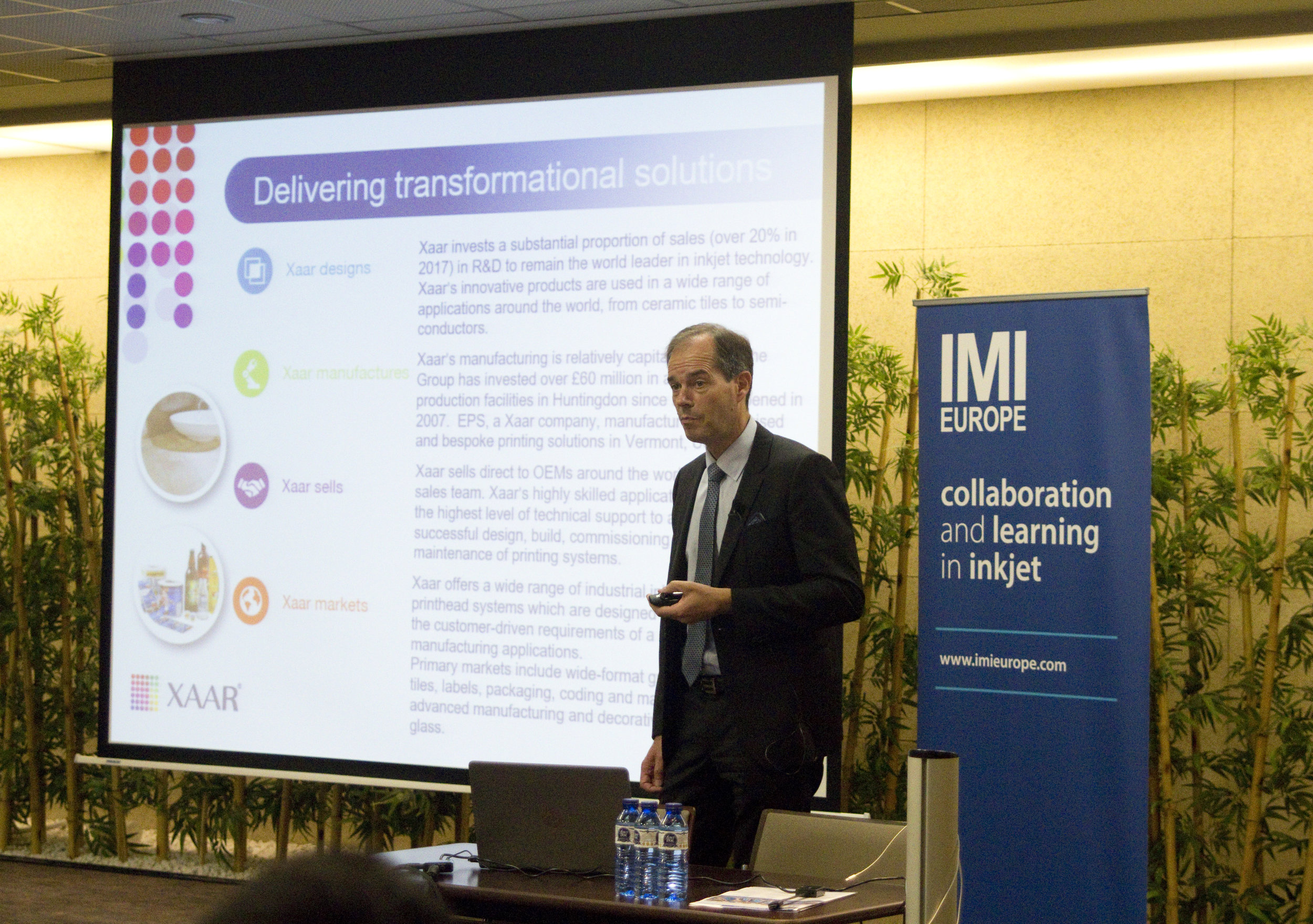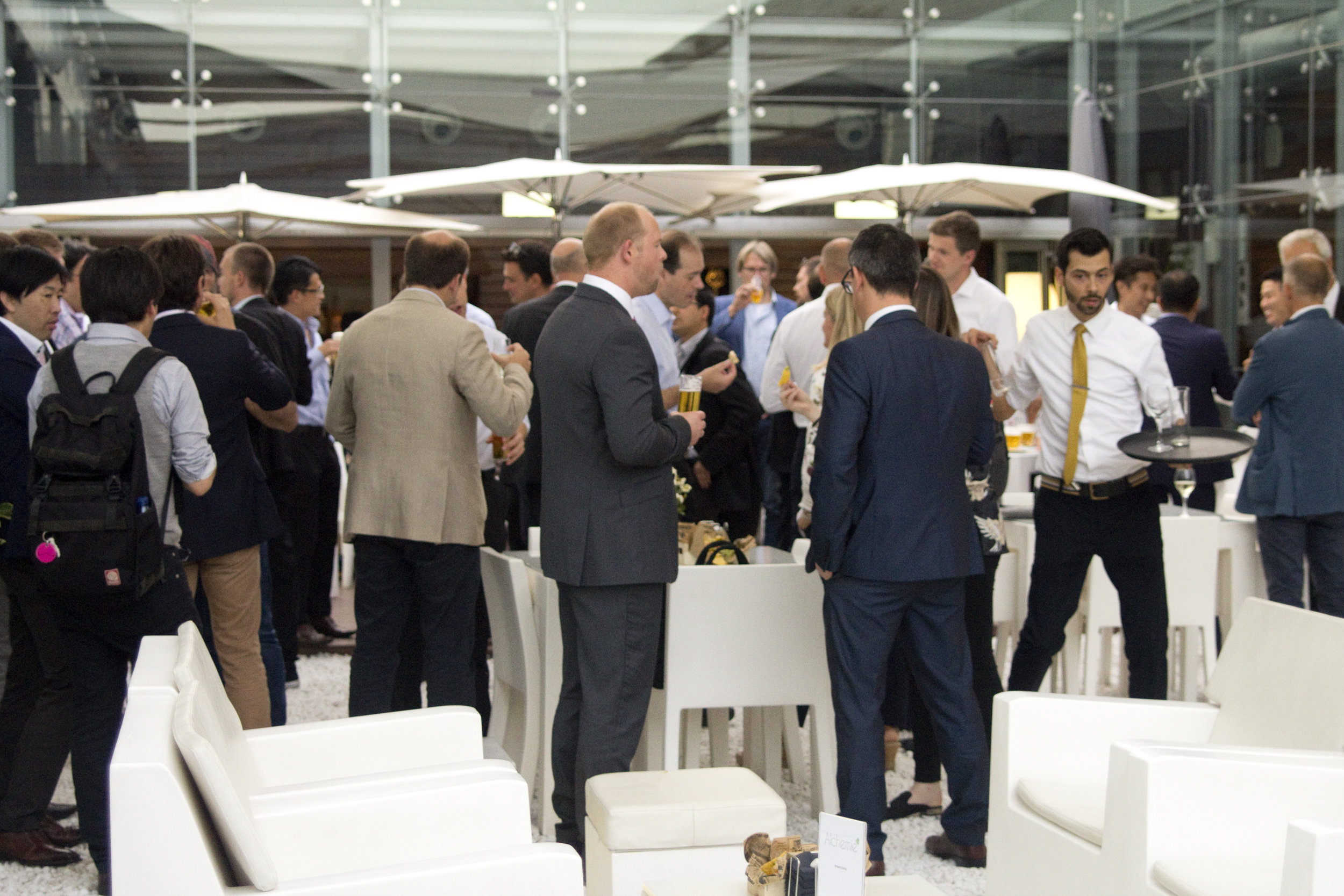On 19-20 September 2018 a group of leading analysts, industry pacesetters, end users and inkjet innovators convened in Barcelona, Spain for IMI Europe’s Digital Printing Conference. This two-day strategic conference was aimed at board level executives, business developers and technical directors across a wide range of digital printing and deposition applications.
Eighteen invited speakers gave strategic presentations on topics including
packaging - perspectives from different sides of the industry and a panel discussion
industrial inkjet - with textile and décor contributors and a panel discussion
direct-to-shape printing
new technologies and advances
a look into print recycling and other topical themes.
The conference delegates came from a range of companies including ink, dispersions and colorants, equipment and other inkjet printing companies, with many of the big industry names represented.
“Of the three conferences we go to this is the most intimate - you can walk up and talk to senior executives so easily. Everyone here knows what they are doing, there are no tourists. We have got many great leads from this event as usual” - Guy Newcombe, CEO, Archipelago Technology
On the days before the conference we held two very well received Market Reports Live sessions, Digital Textile Printing in the morning and Digital Packaging Printing in the afternoon, as well as the continually successful and renowned Inkjet Academy.
The conference was a great success and attracted in-depth discussions and Q&A's after the talks as well as in the breaks and evening reception. The feedback from sponsors, speakers and delegates has been very positive:
“I always really enjoy the IMI conference and it has for many years now provided me and the InPrint Show with a strategically focused platform to really benefit from quality insight, networking and development news for Inkjet. I think the addition of the ‘Market Reports Live’ sessions enhances value even further. I look forward to attending next year.” – Marcus Timson, Director, Co-Founder, InPrint
“The discussions on packaging were really good, I have learned many things” Montserrat Peidró, Senior Vice President - Head of Digital Print Business Unit, Heidelberger Druckmaschinen
“The leads we get at this conference are serious, from OEMs and head suppliers” - Dr Simon Daplyn, Marketing Manager, Sensient Imaging Technologies S.A.
“It’s a good opportunity to catch up on the latest developments in inkjet technology and its commercial applications. The networking opportunities are very useful, and enjoyable” Dr Nick Campbell, Project Manager, Screen GP IJC
There follows a short review of each of the talks and panel sessions. For more information you can contact the speakers or order the conference proceedings and audio.
Day 1 - WEDNESDAY 19 SEPTEMBER
Section 1 – Packaging
Where is the demand for digitally printed packaging?
Marco Boer, Vice President, IT Strategies
Marco’s talk looked at the market from the point of view of a digital solution provider in the packaging space. He pointed out that as packaging is only part of the final product, the development and acceptance route is much longer than in document printing for example. He looked at the total market in terms of brands, and used a decision matrix to identify target companies who were both receptive to the advantages of a digital system and large enough to be able to afford such a development. For example in the folding carton space, he identified 600 potential target companies from a total market of 6000 sites. He made a similar analysis in corrugated and flexible packaging. Such an analysis enables developers to make realistic judgements of their likely business.
Digital inks for packaging
Denis Poncelet, Marketing & Sales Development Director - Inks Europe, Sensient Imaging Technologies
Denis reviewed the impact and challenges for inks in packaging. He identified that graphic appeal, safety and cost are the key factors driving ink and solution choice. For graphic appeal, precise colour matching, special effects like metallic, and white are crucial. Safety is driven by country-specific regulations, especially for food compliance, with food packaging being a major contributor to the total market size. Ink cost is important but the overall print cost is also driven by factors such as whether a primer and/or overcoat are needed.
Digital printing in the packaging supply chain - overview and challenges
Alexander Janoschka, CEO, Janoschka
Alexander reviewed the packaging industry from the perspective of the brands. Packaging design is driven by the need to attract consumers in split-second decisions, requiring packaging that is distinctive and cuts through the other cluttered messages bombarding the consumer. He reviewed a number of ways in which packaging converters are aiming to achieve this, and how digital print can help. One of the challenges is that a packaging design may need to be printing across a range of packaging types, requiring different print technologies which must all produce a matching result. Matching between print and online visions of the brand must also be strong. Alex expects growth of digital in packaging to be strong, and not just in labels, driven by reductions in cost and increases in speed and capability. Mega-trends favouring digital print include individualisation, technological change and sustainability.
Inkjet printheads for digital printing of packaging
Ramon Borrell, Chief Technology Officer, Xaar
Ramon reviewed the current range of Xaar printheads, and the relevance of these for packaging applications. He looked at various packaging applications and the opportunities for digital conversion over the next few years. Examples of digital solutions using Xaar printheads included label printers, digital embellishment solutions using the high laydown capabilities of some printheads, direct-to-container print and flexible packaging. Ramon also looked the requirements printer manufacturers have and how printhead design can help, including consistent print density, reduced print zone size and accurate alignment. He also gave a short history of the development of Xaar’s thin film solution and detailed some of the technology behind it.
Digital label: past, present & future
Michael Ring, Labelfire General Manager, Gallus
Michael Ring looked at the development in digital label over the last 5 years, the lessons learned by Gallus/Heidelberg in that time and also took a look into the future. There are clear drivers to shorter runs leading to demand for digital labels, which has accelerated in the last few years. The economics of label printing make a strong case for in-line converting, and most label presses are designed with this in mind. Michael compared toner and inkjet technology and the reasons for growth on the inkjet side as problems are resolved and toner technology limits are reached. A large number of problems needed to be solved to develop a viable inkjet label press, including image quality issues, ink and substrate compatibility, software stability and many more. Automated nozzle-out detection and compensation has been a vital development, with new screening algorithms also helping greatly. Michael next reviewed the label press marketplace, dividing the market into three levels of press capability and cost (with Gallus currently at the high end). He announced that Gallus has chosen to bypass the crowded middle market and will also launch an inkjet label press into the low end market.
Integrating an inkjet printer into corrugated board manufacture
Dr Nick Campbell & Maximilian Mark,
Project Manager, Screen GP IJC & Product Manager Digital Print, BHS Corrugated Machinery
Maximilian Mark first reviewed the corrugated packaging market trends and requirements, with opportunities to print inline making potentially significant benefits for many packaged products. Inline printing can simplify production processes, reduce waste and energy consumption and ultimately produce printed packaging more quickly. The particulars of corrugated board production lead to specific requirements for a digital printer which were not met by existing print solutions.
Nick Campbell then took over to explain some of the difficulties that needed to be overcome to develop a print solution to met BHS’s requirements. These include printhead effects such as straightness and drop mass uniformity, drop velocity variation along a printhead and between heads. They also needed to develop technology to allow for printing while cleaning, and for missing nozzle detection and correction. Lastly, Nick showed a fantastic video of the prototype solution in operation.
Panel Session: Digital packaging solutions - is inkjet ready?
Panel chair: Denis Poncelet, Marketing & Sales Development Director - Inks Europe, Sensient Imaging Technologies
Panel:
Michael Ring, Labelfire General Manager, Gallus
Ramon Borrell, Chief Technology Officer, Xaar
Marco Boer, Vice President, IT Strategies
Dr Nick Campbell, Project Manager, Screen GP IJC
Alexander Janoschka, CEO, Janoschka
The panel session led to a lively and informative debate, with questions from the chair and several audience members that were answered by panel members.
Section 2 – Recycling & New developments
Is inkjet still a challenge for paper recycling and deinking?
Axel Fischer, INGEDE
Axel described the process used for de-inking of paper as part of the recycling process, which needs to be the same for inkjet printed paper as it cannot be separated from other print types during recycling. Dry toner de-inks well but water-based inks with sub-micron pigments are much harder to de-ink, and dye-based inks are not de-inkable at all. Just a 2% component of dye-based print in a load can make the whole load unusable. Inkjet prints can be made de-inkable by using pre-coats and progress is being made in this area. UV curable inks are also a challenge.
Multi jet fusion - behind the scenes
David Ramirez, Senior R&D Engineer, HP
David Ramirez described the HP 3D printing technology and gave us an insight into their aim to disrupt the $12T manufacturing sector. David explained how the HP technology works, and why 2 agents are jetting during the manufacturing process to control the way the heat lamp fuses the build powder during each layer deposition. HP are looking at using 3D printing for prototyping and preproduction part manufacture, and also for making spare and replacement parts once a product is well along its lifecycle. They have started using the technology in their own manufacturing processes, with benefits in weight, cost and carbon footprint.
Digitising materials science
Dr Alan Hudd, Director & Co-Founder, Alchemie Technology
Alan described how digital manufacturing by depositing materials precisely where they are needed has the potential to transform the way products are made. As part of this, a means of depositing coatings in a precise way is important. Alan described and demonstrated some ways in which their technology is being used to deposit liquids and powders in a precise manner for applications including pill printing and braille.
Sponsors’ Forum
After the main conference talks the event sponsors were able to make a short presentation to introduce their company and products to the audience. There were presentations from Sensient, Sunjet/Sun Chemical, Archipelago Technology, Marabu, Meteor Inkjet and Catenary Solutions.
Evening reception
At the end of the day the delegates enjoyed a food and drinks reception sponsored by Alchemie Technology where they chatted with the other attendees and conference sponsors, whilst enjoying the spectacular views of the sunset across the city of Barcelona from the hotel rooftop bar.
If you missed the event, you can order conference proceedings by going to our Order Proceedings page.
For part 2 of the review, click here.













